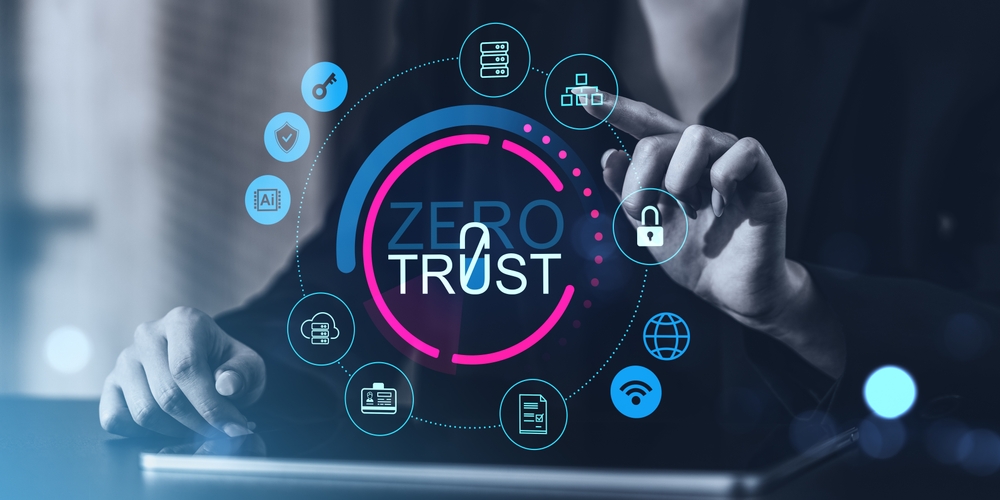Why Modern IT Infrastructure Needs Zero Trust Built-In
- September 22, 2025
- Posted by: Gradeon
- Category: IT Infrastructure

In today’s hyper-connected world, cyber threats have grown more sophisticated than ever before. Traditional security models, which relied on perimeter-based defences, are no longer enough to safeguard organisations against advanced attacks. Businesses now operate in environments where employees access systems remotely, cloud platforms host critical data, and third-party integrations expand the attack surface. Against this backdrop, one principle has gained prominence as the gold standard for cybersecurity: Zero Trust.
Rather than assuming everything inside a network is safe, Zero Trust works on a strict “never trust, always verify” model. For modern IT infrastructure, this shift is not optional – it is essential.
The Flaws of Traditional Security Models
Historically, organisations secured their infrastructure by building a strong perimeter, often likened to a castle-and-moat design. Firewalls, VPNs, and intrusion detection systems created a barrier against external threats, while everything inside the network was treated as trustworthy.
However, this model no longer reflects how businesses operate today. Remote work, cloud adoption, and hybrid infrastructures mean that the “inside” and “outside” of a network have blurred. Attackers who breach the perimeter – whether through phishing, weak credentials, or supply chain vulnerabilities – can move laterally within the system with relative ease.
This outdated model assumes trust too readily, and once attackers are in, they can quietly access sensitive systems undetected. It is this vulnerability that Zero Trust directly addresses.
What Zero Trust Really Means
Zero Trust is not a single tool or product but a security philosophy and framework. Its core principle is simple: never trust a user, device, or application by default – even if it is already inside the network. Every access request must be authenticated, authorised, and continuously validated.
When organisations modernise their IT infrastructure solutions, embedding Zero Trust becomes crucial to ensure that every layer of the system is secured against evolving threats.
Key pillars of Zero Trust include:
- Identity Verification: Ensuring that only legitimate users gain access through multi-factor authentication (MFA) and strong identity controls.
- Least Privilege Access: Granting users and devices the minimum access required to perform their tasks.
- Micro-Segmentation: Dividing networks into smaller zones so that a breach in one area does not spread across the entire infrastructure.
- Continuous Monitoring: Tracking user behaviour, device health, and access requests in real time.
By embedding these principles into IT infrastructure, organisations create a proactive and adaptive defence strategy.
Why Modern IT Infrastructure Needs Zero Trust
1. Rising Threat Landscape
Cybercrime is escalating, with ransomware, phishing, and insider threats costing organisations billions annually. Modern IT systems – spread across on-premises servers, multiple cloud providers, and remote endpoints – create a complex and porous attack surface. Zero Trust helps reduce vulnerabilities by eliminating assumptions of trust.
2. Remote and Hybrid Work Models
The pandemic accelerated the shift to remote and hybrid working. Employees now log in from home networks, shared devices, and public Wi-Fi. A perimeter-based model cannot safeguard these distributed access points. Zero Trust ensures that each login attempt is rigorously verified, regardless of location.
3. Cloud and Multi-Cloud Adoption
Businesses increasingly depend on SaaS platforms and multi-cloud strategies. While cloud providers secure their infrastructure, organisations remain responsible for safeguarding their own data and applications. Zero Trust offers the control and visibility needed to enforce consistent security policies across diverse environments.
4. Compliance and Regulatory Demands
Regulations such as GDPR, DORA, and PCI DSS require strict data protection and access control measures. Implementing Zero Trust principles helps businesses meet compliance requirements by demonstrating strong identity verification, access management, and audit readiness.
5. Minimising Insider Threats
Not all risks come from external attackers. Employees, contractors, and partners with legitimate access can unintentionally – or maliciously – cause data breaches. Zero Trust reduces this risk by applying least privilege access and continuous monitoring of user behaviour.
Building Zero Trust into IT Infrastructure
Transitioning to Zero Trust does not mean ripping out existing systems. Instead, it requires a gradual and strategic integration into IT infrastructure.
- Strengthen Identity and Access Management (IAM):
Deploy MFA, single sign-on (SSO), and role-based access controls to ensure strong user authentication. - Secure Endpoints:
Implement endpoint detection and response (EDR) solutions to verify device health before granting access. - Micro-Segment Networks:
Use network segmentation to limit lateral movement and contain breaches. - Adopt a Cloud-Native Approach:
Integrate Zero Trust principles into cloud workloads, APIs, and SaaS applications to enforce consistent security. - Continuous Monitoring and Analytics:
Employ AI-driven tools to analyse user activity, detect anomalies, and respond to potential threats in real time. - Educate Employees:
Zero Trust is as much about culture as it is about technology. Training employees on security best practices is vital for its success.
Business Benefits of Zero Trust
Beyond strengthening security, adopting Zero Trust delivers tangible business advantages:
- Reduced Risk Exposure: Minimises the impact of breaches by limiting attacker movement.
- Regulatory Readiness: Simplifies compliance reporting and audits.
- Operational Resilience: Ensures business continuity even during cyber incidents.
- Customer Trust: Demonstrates a strong commitment to data protection, enhancing brand reputation.
Zero Trust as a Business Imperative
Modern IT infrastructure services are dynamic, distributed, and constantly evolving. Traditional security models cannot keep pace with today’s digital risks. By embedding Zero Trust into the very foundation of IT infrastructure, organisations can future-proof their defences against both current and emerging threats.
Zero Trust is no longer a “nice to have.” It is a business imperative – one that ensures resilience, compliance, and trust in an age where cyber attacks are inevitable. The organisations that align their IT infrastructure services with Zero Trust principles today will be the ones best positioned to thrive securely in tomorrow’s digital economy.
